Knorr-Bremse Bundle
Decoding Knorr-Bremse: Who Are Their Customers, and Why Does It Matter?
In the intricate world of transportation technology, understanding the 'who' and 'where' of your customer base is crucial for success. For Knorr-Bremse, a leader in braking systems and related technologies, knowing its customer demographics and target market is not just beneficial—it's essential. This deep dive explores the diverse customer profiles that drive Knorr-Bremse's global operations, from railway operators to commercial vehicle manufacturers, and the strategies they employ to meet their needs.
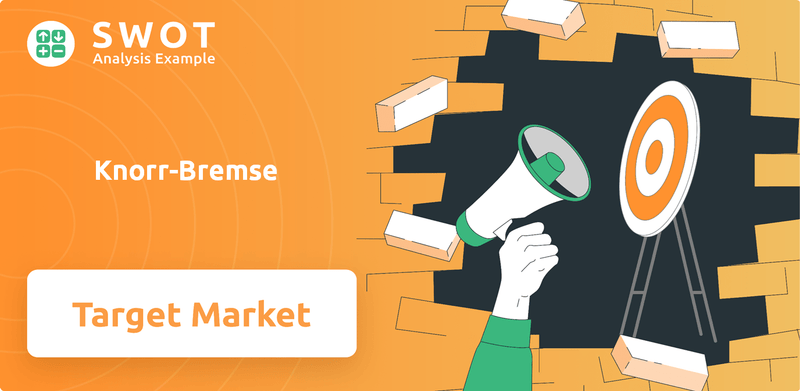
This analysis will provide a comprehensive overview of Knorr-Bremse's customer landscape, offering insights into their Knorr-Bremse SWOT Analysis, market segmentation, and strategic approaches. By examining Knorr-Bremse's customer profile, including their needs and preferences, we can better understand how the company navigates the complexities of the braking systems industry and maintains its market share. Moreover, we'll explore Knorr-Bremse's customer demographics across various vehicle types and geographical locations, offering a clear picture of their target market and customer acquisition strategies.
Who Are Knorr-Bremse’s Main Customers?
Understanding the primary customer segments is crucial for analyzing the business strategy of Knorr-Bremse. The company operates primarily in a Business-to-Business (B2B) model, focusing on two main customer groups: rail vehicle manufacturers and commercial vehicle manufacturers. This B2B approach means that Knorr-Bremse directly supplies its products to other businesses rather than individual consumers, shaping its customer demographics and target market.
These customer segments are characterized by their size, operational needs, and decision-making processes. The rail and commercial vehicle sectors demand high reliability, safety, and efficiency. Knorr-Bremse's customer profile is shaped by these requirements, influencing its product development, sales strategies, and overall market approach. The company's success hinges on meeting the specific needs of these key players in the transportation industry.
The customer base of Knorr-Bremse is diverse, spanning across the globe. Key locations include Europe, North America, and Asia, reflecting the global nature of the transportation industry. This geographical spread requires Knorr-Bremse to adapt its strategies to various regional market dynamics and customer preferences. For more insights into the company's structure, consider exploring Owners & Shareholders of Knorr-Bremse.
The rail vehicle segment includes major train builders such as Siemens, Alstom, and Stadler, as well as railway operators and maintenance companies. These customers prioritize reliability, safety, and long-term operational efficiency. Decision-makers typically consist of experienced engineers, project managers, and procurement specialists.
The commercial vehicle segment focuses on leading truck and bus manufacturers like Daimler Truck, MAN, Scania, and Volvo. This segment also includes fleet operators and aftermarket service providers. Key considerations include fuel efficiency, payload optimization, driver comfort, and safety. These customers often have faster product development cycles.
Knorr-Bremse's customer base is spread globally, with significant concentrations in Europe, North America, and Asia. This distribution reflects the global nature of the transportation industry and the company's broad market reach. The company adapts its strategies to regional market dynamics.
In 2023, the Commercial Vehicle Systems division reported an order intake of approximately €4.1 billion. The Rail Vehicle Systems division also showed robust performance, with an order intake of €4.5 billion. These figures highlight strong demand from global manufacturers and operators.
Knorr-Bremse's target market is evolving due to global trends like autonomous driving and electromobility. The company is expanding its offerings in driver assistance systems and intelligent braking solutions to meet the needs of next-generation vehicles. Digitalization in rail transport is driving investment in digital solutions and connectivity.
- The increasing focus on autonomous driving and electromobility in commercial vehicles is a key driver.
- Digitalization of rail transport is prompting investment in digital solutions and connectivity.
- Market research indicates growing demand for advanced technologies and sustainable solutions.
- Knorr-Bremse adapts to these shifts by expanding its product offerings and targeting customers developing advanced technologies.
Knorr-Bremse SWOT Analysis
- Complete SWOT Breakdown
- Fully Customizable
- Editable in Excel & Word
- Professional Formatting
- Investor-Ready Format
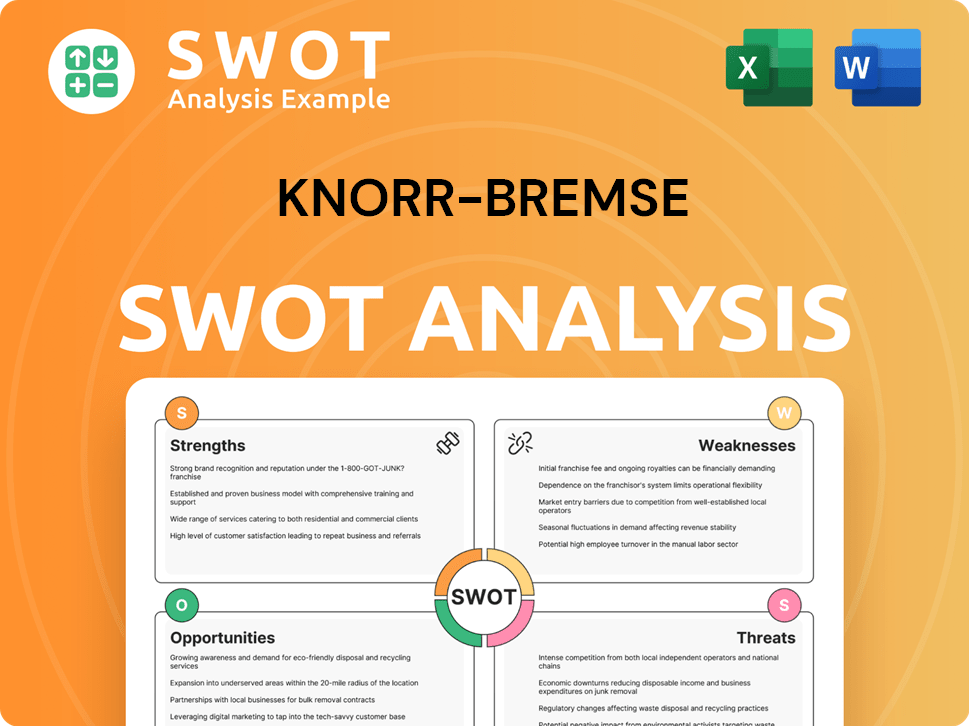
What Do Knorr-Bremse’s Customers Want?
The needs and preferences of Knorr-Bremse's customers are centered around safety, reliability, efficiency, and technological advancement. This focus is critical for both rail and commercial vehicle manufacturers, for whom Knorr-Bremse's braking systems are essential. The demand is for products that meet strict international safety standards and perform well under various operating conditions.
Reliability is also a key factor, as system failures can cause major operational disruptions and financial losses. Customers prioritize products that have long service lives and need minimal maintenance. Purchasing decisions involve long sales cycles, extensive testing, and a strong emphasis on supplier reputation and a proven track record.
The purchasing behavior of the Knorr-Bremse target market is influenced by the total cost of ownership (TCO), which includes maintenance, energy consumption, and potential downtime. For example, solutions for energy-efficient braking and climate control systems help reduce operational costs. In 2023, Knorr-Bremse invested €400 million in research and development, showing its commitment to meeting evolving customer needs through innovation.
Product usage is typically continuous and demanding due to the 24/7 nature of transportation. Loyalty is built on consistent product quality, responsive customer service, and the ability to provide integrated solutions and aftermarket support.
Common pain points addressed include reducing vehicle weight, improving fuel efficiency, enhancing driver comfort and safety through advanced driver assistance systems, and integrating smart technologies for predictive maintenance.
Feedback from customers, gathered through direct engagement and partnerships, significantly influences product development. For instance, the demand for quieter braking systems in urban rail environments has led to innovations in friction materials.
The company tailors its marketing by emphasizing its expertise, global service network, and commitment to innovation, often showcasing real-world applications and customer success stories.
Knorr-Bremse continues to focus on innovation to meet the evolving needs of its customers, including advancements in braking systems and related technologies. This is crucial in the competitive Knorr-Bremse industry.
Strategic partnerships play a key role in understanding and addressing customer needs. Collaborations help in gathering insights and developing solutions that align with market demands.
The primary needs of Knorr-Bremse's customers include safety, reliability, and efficiency. These needs drive the demand for high-quality braking systems and related products. Knorr-Bremse's focus on these areas is critical for its Knorr-Bremse customer profile.
- Safety: Ensuring the safety of passengers and cargo is a top priority.
- Reliability: Minimizing downtime and operational disruptions.
- Efficiency: Reducing operational costs through energy-efficient solutions.
- Technological Advancement: Integrating smart technologies for predictive maintenance and enhanced performance.
For more insights into the company's strategic direction, consider reading the Growth Strategy of Knorr-Bremse.
Knorr-Bremse PESTLE Analysis
- Covers All 6 PESTLE Categories
- No Research Needed – Save Hours of Work
- Built by Experts, Trusted by Consultants
- Instant Download, Ready to Use
- 100% Editable, Fully Customizable
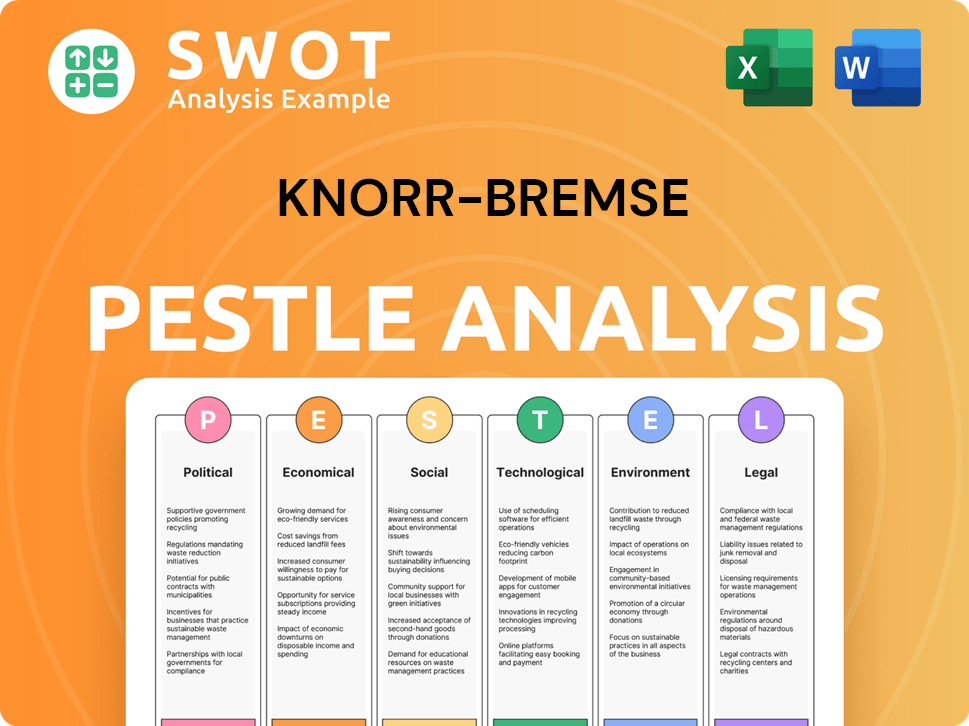
Where does Knorr-Bremse operate?
The geographical market presence of Knorr-Bremse is extensive, spanning across major continents. Its strategic focus lies in Europe, North America, and Asia, where the rail and commercial vehicle sectors are highly developed. This global footprint allows the company to cater to diverse customer demographics and market demands, ensuring a robust and diversified revenue stream.
In Europe, Knorr-Bremse holds a significant market share, particularly in countries like Germany, France, and the UK. The company's strong brand recognition and established relationships with major vehicle manufacturers and railway networks contribute to its success in this region. North America is another crucial market, with substantial operations in the United States and Canada, driven by the commercial vehicle sector and ongoing rail infrastructure investments. This positions Knorr-Bremse as a key player in the braking systems industry.
Asia, especially China and India, represents a rapidly expanding market for Knorr-Bremse, with distinct customer demographics and preferences. The company has strategically adapted its offerings and expanded its manufacturing footprint in these regions to meet local market demands and regulatory requirements. This localization strategy is critical for maintaining market share and driving growth across various global regions. For a deeper dive into the company's financials and market position, you can check out this article about Knorr-Bremse's market analysis.
Knorr-Bremse has a strong market share in Europe, particularly in Germany, France, and the UK. The company benefits from established relationships with major vehicle manufacturers and robust railway networks. This strong presence is a key factor in its overall global success.
North America is a significant market for Knorr-Bremse, with substantial operations in the United States and Canada. This market is driven by the large commercial vehicle sector and ongoing investments in rail infrastructure. The company's presence is crucial in this region.
Asia, especially China and India, is a rapidly growing market for Knorr-Bremse. These regions have distinct customer demographics and preferences, with a focus on cost-effectiveness. The company has localized its offerings and expanded its manufacturing footprint to meet local demands.
In 2023, Knorr-Bremse's sales in the EMEA region (Europe, Middle East, and Africa) accounted for approximately 52% of its total sales. North America contributed around 24%, and Asia/Pacific 22%. This demonstrates the company's balanced global presence.
Knorr-Bremse Business Model Canvas
- Complete 9-Block Business Model Canvas
- Effortlessly Communicate Your Business Strategy
- Investor-Ready BMC Format
- 100% Editable and Customizable
- Clear and Structured Layout
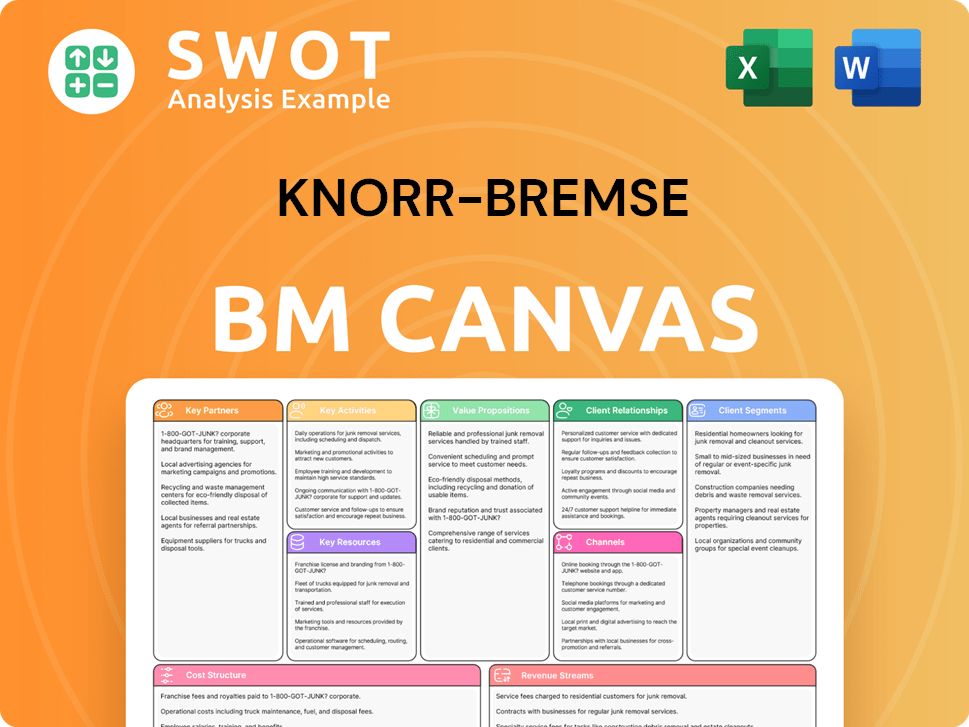
How Does Knorr-Bremse Win & Keep Customers?
The company, a leading player in the mobility industry, focuses on acquiring and retaining customers through a robust, multifaceted approach. Given its business-to-business (B2B) model, the company prioritizes direct sales and long-term relationship management. Its strategies are designed to build strong, lasting partnerships with vehicle manufacturers and operators, emphasizing quality, technological leadership, and comprehensive service.
Marketing efforts include showcasing innovations at major industry events like InnoTrans and IAA Transportation, which are pivotal for directly engaging with potential and existing customers. Digital marketing, using professional platforms and industry-specific publications, provides detailed product information and technical specifications. These strategies are supported by a skilled global sales force that works closely with clients from the initial design phase through aftermarket support.
Customer data and CRM systems are crucial for segmenting customers and managing relationships. The company leverages these systems to track interactions, understand purchasing histories, and predict future needs, enabling personalized communication and service. This data-driven approach supports the company's aim to enhance customer loyalty and ensure sustained revenue streams, contributing to its market leadership.
The company's acquisition strategies heavily rely on direct sales and participation in major industry trade shows. These events, such as InnoTrans and IAA Transportation, provide platforms to showcase the latest innovations and engage with potential customers. Digital marketing, including professional platforms and industry-specific publications, supports these efforts by providing detailed product information.
Sales tactics involve a global sales force that works closely with vehicle manufacturers and operators. This consultative approach ensures tailored solutions from the initial design phase through product integration and aftermarket support. A focus on understanding and meeting specific customer needs is central to this strategy.
Exceptional after-sales service, including spare parts supply, maintenance support, and training programs, is a key element of the company's retention strategies. A global service network ensures rapid response times and expert assistance, minimizing vehicle downtime. Long-term supply agreements and strategic partnerships also contribute to customer retention.
Loyalty programs manifest as long-term supply agreements and strategic partnerships, integrating the company into the customer's supply chain and product development process. The continuous development of predictive maintenance solutions and digital services enhances operational efficiency and cost savings for customers, deepening their reliance on the company's ecosystem.
The company's customer profile primarily includes vehicle manufacturers and operators in the rail and commercial vehicle sectors. These customers range from large multinational corporations to regional transport providers. Brief History of Knorr-Bremse highlights the company's evolution and its focus on these key demographics.
- Rail Vehicle Manufacturers: Companies that design and manufacture trains, trams, and other rail vehicles.
- Commercial Vehicle Manufacturers: Producers of trucks, buses, and trailers.
- Rail Operators: Companies that operate passenger and freight rail services.
- Commercial Vehicle Fleets: Businesses that operate large numbers of trucks and buses.
Market analysis involves understanding industry trends, competitive landscapes, and customer needs. Segmentation is based on vehicle type, geographic location, and operational requirements. This detailed segmentation allows for targeted marketing and sales efforts, ensuring that the company's offerings meet specific customer needs.
Customers value reliability, safety, and efficiency. They seek solutions that minimize downtime, reduce operating costs, and enhance performance. The company addresses these needs by offering advanced braking systems, door systems, and other technologies designed to improve vehicle performance and safety.
Customer service includes providing spare parts, maintenance support, and training. The company's global service network ensures rapid response times and expert assistance. This comprehensive support system is crucial for maintaining high levels of customer satisfaction and loyalty.
The company is focused on trends such as autonomous driving, electrification, and digitalization. Investments in R&D are aimed at developing innovative solutions that meet the evolving demands of the market. The company's strategic focus on these trends positions it for continued growth and market leadership.
The company serves customers worldwide, with a significant presence in Europe, North America, and Asia. Key customer locations are strategically distributed to ensure comprehensive coverage and localized support. This global footprint allows the company to meet diverse regional needs.
The company employs several strategies to acquire new customers, including participating in industry events, leveraging digital marketing, and direct sales efforts. These strategies aim to showcase the company's innovative solutions and build relationships with potential customers. The company's focus on innovation and customer-centric solutions has been a consistent theme in its annual reports, with substantial investments in R&D to meet evolving customer demands and maintain its competitive edge.
Knorr-Bremse Porter's Five Forces Analysis
- Covers All 5 Competitive Forces in Detail
- Structured for Consultants, Students, and Founders
- 100% Editable in Microsoft Word & Excel
- Instant Digital Download – Use Immediately
- Compatible with Mac & PC – Fully Unlocked
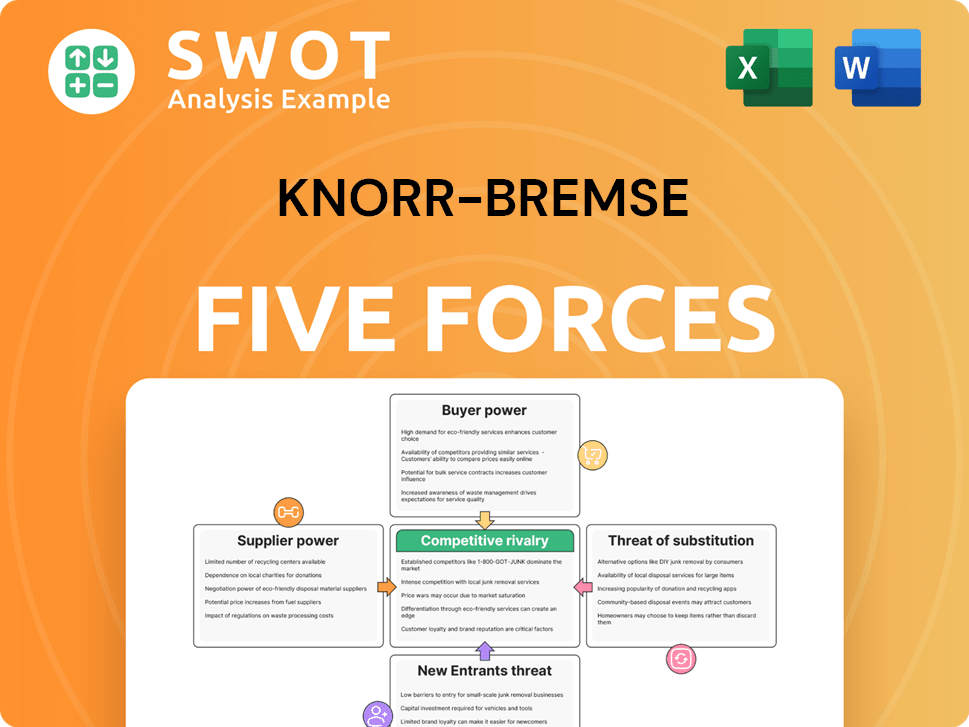
Related Blogs
- What are Mission Vision & Core Values of Knorr-Bremse Company?
- What is Competitive Landscape of Knorr-Bremse Company?
- What is Growth Strategy and Future Prospects of Knorr-Bremse Company?
- How Does Knorr-Bremse Company Work?
- What is Sales and Marketing Strategy of Knorr-Bremse Company?
- What is Brief History of Knorr-Bremse Company?
- Who Owns Knorr-Bremse Company?
Disclaimer
All information, articles, and product details provided on this website are for general informational and educational purposes only. We do not claim any ownership over, nor do we intend to infringe upon, any trademarks, copyrights, logos, brand names, or other intellectual property mentioned or depicted on this site. Such intellectual property remains the property of its respective owners, and any references here are made solely for identification or informational purposes, without implying any affiliation, endorsement, or partnership.
We make no representations or warranties, express or implied, regarding the accuracy, completeness, or suitability of any content or products presented. Nothing on this website should be construed as legal, tax, investment, financial, medical, or other professional advice. In addition, no part of this site—including articles or product references—constitutes a solicitation, recommendation, endorsement, advertisement, or offer to buy or sell any securities, franchises, or other financial instruments, particularly in jurisdictions where such activity would be unlawful.
All content is of a general nature and may not address the specific circumstances of any individual or entity. It is not a substitute for professional advice or services. Any actions you take based on the information provided here are strictly at your own risk. You accept full responsibility for any decisions or outcomes arising from your use of this website and agree to release us from any liability in connection with your use of, or reliance upon, the content or products found herein.